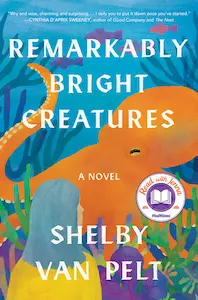Remarkably Bright Creatures - Summary
Shelby Van Pelt

Introduction
“Remarkably Bright Creatures” by Shelby Van Pelt is a captivating and thought-provoking book that delves into the fascinating world of animal intelligence. In this book summary, we will explore the author’s insights and discoveries about the remarkable cognitive abilities of various creatures. By examining specific examples and anecdotes from the book, we will gain a deeper understanding of the complex minds and behaviors of these remarkable animals.
The Intelligence of Dolphins
One of the most intriguing chapters in “Remarkably Bright Creatures” focuses on the intelligence of dolphins. Van Pelt shares numerous anecdotes that highlight the remarkable cognitive abilities of these marine mammals. For instance, she recounts the story of a dolphin named Merlin who was able to recognize himself in a mirror, a behavior previously thought to be exclusive to humans and a few other primates. This example demonstrates the self-awareness and advanced cognition possessed by dolphins.
The Problem-Solving Skills of Crows
Another captivating section of the book explores the problem-solving skills of crows. Van Pelt shares an anecdote about a group of crows in Japan that learned to crack open nuts by dropping them onto a busy street, allowing cars to run over them and break the shells. This behavior showcases the crows’ ability to use tools and adapt their strategies to solve complex problems. Such examples challenge the traditional notion that only humans possess advanced problem-solving skills.
The Social Complexity of Elephants
In “Remarkably Bright Creatures,” Van Pelt also delves into the social complexity of elephants. She describes how these majestic creatures exhibit a strong sense of empathy and cooperation within their herds. Anecdotes from the book highlight instances where elephants have displayed mourning behaviors, comforting each other during times of distress or loss. These examples emphasize the emotional intelligence and social bonds that exist within elephant communities.
The Tool Use of New Caledonian Crows
New Caledonian crows are renowned for their exceptional tool use, a topic explored in detail by Van Pelt. The author recounts experiments where these birds fashion specialized tools to extract grubs from tree bark. This ability to create and use tools showcases their remarkable problem-solving skills and cognitive flexibility. By including such anecdotes, Van Pelt provides compelling evidence of the intelligence and adaptability of these fascinating creatures.
The Problem-Solving Prowess of Octopuses
Octopuses, often underestimated for their intelligence, are given due recognition in “Remarkably Bright Creatures.” Van Pelt shares anecdotes about octopuses escaping from seemingly secure enclosures, demonstrating their problem-solving prowess. She also highlights their ability to camouflage and mimic other creatures, showcasing their remarkable cognitive abilities. These examples challenge our preconceived notions about the intelligence of invertebrates.
The Emotional Lives of Dogs
“Dogs are man’s best friend,” and Van Pelt explores the emotional lives of these beloved companions in her book. She shares heartwarming anecdotes about dogs displaying empathy, loyalty, and understanding. Whether it’s a dog comforting its owner during times of distress or displaying joy upon their return, these stories highlight the emotional intelligence and deep connections that exist between humans and dogs.
The Language Skills of Parrots
Parrots have long been known for their ability to mimic human speech, but “Remarkably Bright Creatures” delves deeper into their language skills. Van Pelt shares anecdotes about parrots using words and phrases in context, demonstrating an understanding of their meaning. These examples challenge the notion that language is solely a human trait and shed light on the impressive cognitive abilities of these colorful avian creatures.
The Problem-Solving Abilities of Apes
Apes, our closest relatives in the animal kingdom, possess remarkable problem-solving abilities, as explored by Van Pelt. She recounts anecdotes about apes using tools, solving complex puzzles, and even displaying a basic understanding of numerical concepts. These examples highlight the cognitive similarities between humans and apes, emphasizing the intelligence and adaptability of these incredible creatures.
The Navigation Skills of Homing Pigeons
Homing pigeons have long fascinated humans with their extraordinary navigation skills, and Van Pelt explores this topic in her book. She shares anecdotes about pigeons successfully finding their way home over vast distances, often without any visual cues. These stories shed light on the remarkable spatial memory and navigational abilities of these birds, challenging our understanding of animal cognition.
The Memory of Elephants
Elephants, known for their exceptional memory, are given further attention in “Remarkably Bright Creatures.” Van Pelt shares anecdotes about elephants recognizing individuals they haven’t encountered in years and remembering specific locations with great accuracy. These examples highlight the impressive long-term memory capabilities of these gentle giants, further solidifying their reputation as remarkably intelligent creatures.
Conclusion
“Remarkably Bright Creatures” by Shelby Van Pelt provides a captivating exploration of animal intelligence, challenging our preconceived notions about the cognitive abilities of various species. Through engaging anecdotes and thought-provoking examples, the book highlights the remarkable problem-solving skills, emotional intelligence, and social complexity exhibited by dolphins, crows, elephants, octopuses, dogs, parrots, apes, pigeons, and elephants. By delving into the fascinating world of animal cognition, Van Pelt inspires readers to appreciate and respect the remarkable minds of these creatures that share our planet.